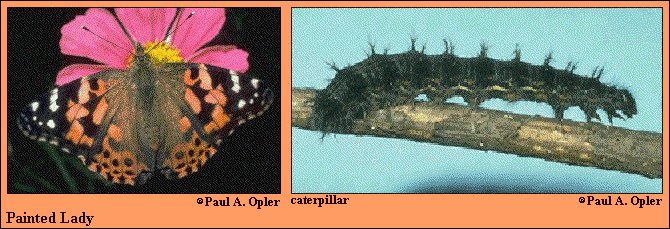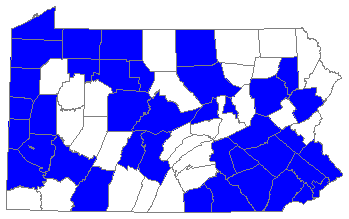 |
 

 |



Painted Lady (Vanessa cardui [Linnaeus])
Wing span: 2 - 2 7/8 inches (5.1 - 7.3 cm).
Identification: Upperside is orange-brown with darker wing bases; forewing with black apex patch and white bar on leading edge; hindwing submarginal row of 5 small black spots sometimes has blue scales. Underside has a black, brown, and gray pattern with 4 small submarginal eyespots.
Life history: Males perch and patrol during the afternoon for receptive females. In the West males usually perch on shrubs on hilltops, while in the East males perch on bare ground in open areas. Females lay eggs singly on the tops of host plant leaves. Caterpillars live in silk nests and eat leaves. Adults hibernate only in the South and in mild winters.
Flight: One to three flights in the East from May-October, three to four flights in South Texas from October-April.
Caterpillar hosts: More than 100 host plants have been noted; favorites include thistles (Asteraceae), hollyhock and mallow (Malvaceae), and various legumes (Fabaceae).
Adult food: The Painted Lady prefers nectar from composites 3-6 feet high, especially thistles; also aster, cosmos, blazing star, ironweed, and joe-pye weed. Flowers from other families that are visited include red clover, buttonbush, privet, and milkweeds.
Habitat: Almost everywhere, especially in open or disturbed areas including gardens, old fields, dunes.
Range: On all continents except Australia and Antarctica. From the deserts of northern Mexico, the Painted Lady migrates and temporarily colonizes the United States and Canada south of the Arctic. Occasionally, population explosions in Mexico will cause massive northward migrations.
Comments: The Painted Lady is also known as the Thistle Butterfly because of the caterpillars' food preference and also as the Cosmopolitan because it is the most widely distributed butterfly in the world.
Conservation: Not required.
The Nature Conservancy Global Rank: G5 - Demonstrably secure globally, though it may be quite rare in parts of its range, especially at the periphery.
Management needs: None reported.
References:
Opler, P. A. and G. O. Krizek. 1984. Butterflies east of the Great Plains. Johns
Hopkins University Press, Baltimore. 294 pages, 54 color plates.
Opler, P. A. and V. Malikul. 1992. A field guide to eastern butterflies. Peterson
field guide #4. Houghton-Mifflin Co., Boston. 396 pages, 48 color plates.
Scott, J. A. 1986. The butterflies of North America. Stanford University Press,
Stanford, Calif. 583 pages, 64 color plates.
Tilden, J. W. 1986. A field guide to western butterflies. Houghton-Mifflin Co.,
Boston, Mass. 370 pages, 23 color plates.
Author: Jane M. Struttmann
State and Regional References:
Glassberg, J. 1993. Butterflies Through Binoculars: A Field Guide to
Butterflies in the Boston-New York-Washington Region. Oxford Univ. Press,
New York, N.Y. 160 pp.
Layberry, R.A., Hall, P.W. & Lafontaine, D.J., 1998. The Butterflies of
Canada. University of Toronto Press, Toronto, ON. 280 pp.
Opler, P.A. 1998. A field guide to eastern butterflies, revised format.
Houghton Mifflin Co., Boston.
Shapiro, A.M. 1966. Butterflies of the Delaware Valley. American Entomological
Society Special Publication. Philadelphia, PA. 79 pp.
Tietz, H.M. 1952. The Lepidoptera of Pennsylvania. The Pennsylvania State
College School of Agriculture Agricultural Experiment Station. State
College, PA. 194 pp.
Wright, D.M. 1995, Atlas of Pennsylvania Butterflies. Special Private
Publication, Lansdale, PA. 22 pp.

